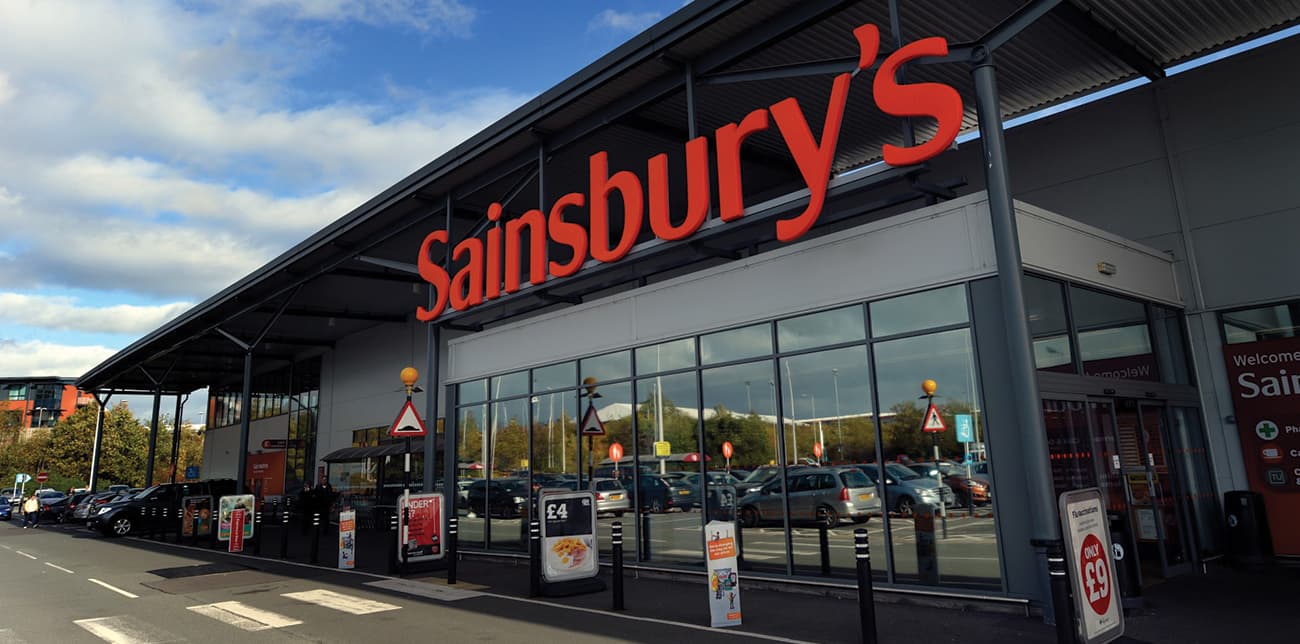The name “Sainsbury’s” is familiar to people across all demographics and age groups in terms of quality and affordable grocery shopping in the United Kingdom. Rising from humble origins in the 19th Century, Sainsbury’s long-term growth remains one of the biggest success stories in the UK business world. It is the second-largest supermarket chain in the entire United Kingdom, overseeing more than 1,400 locations found all across the country, employing 117,000 workers, and holding 16% of the total supermarket sector. Given the company’s success, any business manager seeking to expand his or her operations would benefit from an in-depth look at Sainsbury’s marketing strategy. Together we will analyze how the brand utilized new and innovative marketing mix strategies to rise to the second-largest supermarket chain in the UK.
While numerous marketing strategies have been effective in building and expanding Sainsbury’s brand, the one strategy that has seen the most sustained success has been the company’s commitment to omnichannel marketing. This is a marketing strategy that prioritizes the integration and cooperation between the various channels that a company uses to reach its customer base. In other words, an omnichannel marketing approach will not see each marketing channel as a discrete and isolated resource. Instead, it sees the entirety of a company’s marketing channels as representing a cohesive whole that contains marketing potential greater than the sum of its parts.
In a hurry? Listen to our Sainsbury story on the go:
Sainsbury’s history: the early years to this day
The early years
When looking at the widespread success of the Sainsbury’s brand in the UK today, it can be hard to imagine the company’s humble origins. But the truth is that Sainsbury’s did not always boast thousands of stores and over one hundred thousand employees across the country. In fact, Sainsbury’s success arose from a tiny shop on a nondescript London corner.
In 1869, London grocers John James and Mary Ann Sainsbury opened up a small grocery shop on London’s Drury Lane. Though the shop was small, the Sainsburys quickly built a recognizable brand that stood out from the competition. Mr. Sainsbury’s recognized that grocery shoppers in London were all too often forced to choose between low prices and basic cleanliness and food quality standards. By offering competitive prices, high-quality products, and a level of hygiene and health standards rarely matched at that time, Sainsbury’s brand quickly become one of the most well-regarded in all of London.
Within a few years, the Sainsburys found that their single Drury Lane shop was not sufficient to meet the growing demand that came with their rising brand recognition. By 1881, the couple opened three more shops throughout London. The following year, they opened a fourth store in Croydon, their first location outside of London. This location quickly became their flagship store.
In 1884, Sainsbury’s began selling products under its own label, beginning with pork sausages and expanding from there. This was the first of many instances of Sainbury’s marketing strategy prioritizing multiple channels to reach and expand its customer base, but more on that later.
Continuous expansion

By the turn of the 20th Century, Sainsbury’s was expanding at an exponential rate. In 1903, the company proudly opened its one-hundredth store. And over the next several decades, the expansion continued through additional marketing success and brand acquisitions. In 1936 Sainsbury’s acquired the Thoroughgood’s brand of grocery stores, allowing them to expand even further throughout the Midlands.
By the 1970s, Sainsbury’s had expanded beyond the south of England and opened locations in Yorkshire, Wales, Scotland, and Northern Ireland. At this point, Sainsbury’s marketing strategy had reached its zenith with the company becoming the largest and most recognizable chain of supermarkets in the entire United Kingdom.
Today, Sainsbury’s is proud to continue the tradition of excellence that started with John James and Mary Ann in their humble Drury Lane shop. With thousands of locations across the UK, the Sainsbury’s brand features both large-scale supermarkets and small-scale convenience stores, numerous lines of products, and subsidiaries such as Sainsbury’s Bank, Sainsbury’s Energy, and the catalog retailer Argos.
How Sainsbury’s marketing strategy drives growth

Source: Statista
Of course, Sainsbury’s sustained success over the course of three centuries is largely due to the company’s high-quality products, excellent standards, and exceptional customer service. But while these qualities are certainly necessary for sustained success at the national level, other factors and strategies play a role as well.
In many cases, Sainsbury’s success also stems from a bold and dynamic marketing strategy that implements a number of different approaches in a manner that is comprehensive and interconnected. While Sainsbury’s has successfully implemented dozens of effective marketing strategies over the last several decades, six stand out as most indicative of their successful approach.
Key Strategy #1: Going omnichannel
Sainsbury’s marketing strategy has successfully implemented an omnichannel marketing focus across its numerous marketing outlets. In addition to the effective innovation of in-store and online shopping options, the company has also successfully integrated its various product lines with its shopping experience. Not only does it offer its own high-quality brands of products, but the company has also invested in developing delicious recipes for a wide variety of dishes, which are then streamlined with its online and in-store shopping experiences.
For a chain of grocery stores, an omnichannel marketing approach will provide customers with a comprehensive and unified shopping experience between in-store, online, and catalog retailing. In this case, Sainsbury’s marketing segmentation flourished when the company committed to an omnichannel approach. Such an approach has allowed it to divide its core customer base into more useful marketing sub-groups to which the company can market specific products and services more directly.
Additionally, Sainsbury’s digital marketing strategy has successfully integrated its in-store and online shopping experiences into a complementary omnichannel medium. Their customers can shop for groceries online and then pick them up at the nearest store location. They have also introduced the use of grocery delivery for customers who wish to do their shopping without needing to leave their homes.
Key Strategy #2: Pandemic damage control
In light of the COVID-19 pandemic, Sainsbury’s was able to mitigate a potential crisis by integrating its online retailing options with its preexisting customer service structure. With enhanced online shopping and delivery options, Sainsbury’s successfully reached out to a significant customer base who did not wish to shop in person.
Within a year, Sainsbury’s had the fastest growth in online shopping of all major supermarket retailers. By employing cutting-edge omnichannel marketing principles, Sainsbury’s marketing strategy serves as a useful case study for anyone in the business and marketing world who is looking to rise above the competition and help their business to thrive.
Key Strategy #3: Shifting brand positioning
Another excellent example of Sainsbury’s marketing strategy is its ability to shift its brand position based on the changing preferences of its customer base. For many years, Sainsbury’s marketed itself under the slogan “Live Well for Less.” However, as times changed, marketing data began to suggest that Sainsbury’s customer base was starting to prioritize healthy eating habits and overall bodily wellness when making decisions on where and how to shop.
In 2021, Sainsbury’s changed its slogan to the new “Helping Everyone Eat Better.” While Sainsbury’s pricing strategy still remains a significant and long-term focus for the company, the revised slogan proved to be a better match for a contemporary customer base with an emphasis on healthy eating and sustainable food production. Sainsbury’s promotion strategy in this instance shows that a company need not be beholden to past traditions when faced with changing preferences in its customer base.

Key Strategy #4: Stellar supply chain

In addition to its commitment to omnichannel marketing and brand positioning evolution, Sainsbury’s has also successfully implemented an excellent supply chain into its marketing approach. By prioritizing the quality of its products, Sainsbury’s has been able to associate its brand name with freshness, high standards, and ethical sourcing. Its customer base does not wish to sacrifice food quality in pursuit of lower prices; so the company has been able to market a stellar supply chain to its customers as a means of creating a brand association between the company’s competitive prices and high-quality products.
With 33 distribution centers and a seamless chain of transportation and storage, Sainsbury’s is able to ensure that its customers are able to purchase high-quality products at affordable prices. Today, it sources products from hundreds of suppliers in over 70 companies. What’s more, the company ensures that the suppliers it partners with are able to meet the company’s high standards for the products sold to its customers.
Key Strategy #5: Locally-sourced products
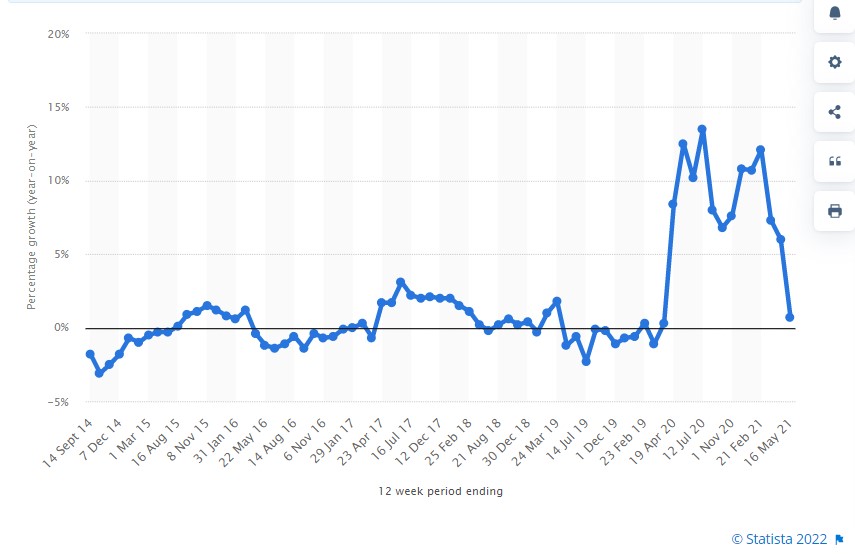
Related to the company’s excellent supply chain, Sainsbury’s has successfully marketed itself in terms of its locally-sourced products for the British public. Today, Sainsbury’s oversees innovative development groups for its farmers and suppliers, specifically prioritizing farms within the United Kingdom. With around 1,300 members across Britain, Sainsbury’s development groups provide the added bonus of investing in British business and agriculture. Thus, Sainsbury’s is able to appeal to its customer base by means of its investment in homegrown British products.
Key Strategy #6: Consumer choice and convenience
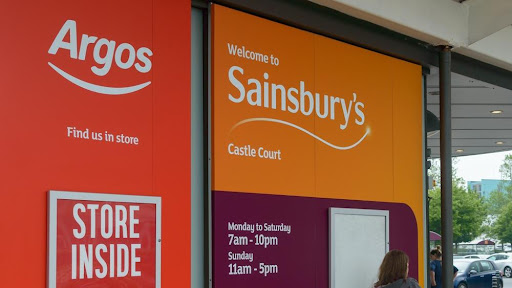
Another major selling point for Sainsbury’s brand is the high level of choice and convenience in the shopping experience that it provides customers. Today, the company markets several of its own brands through various locations, including the Argos and Habitat brands. However, Sainsbury’s stores offer a variety of other brands and products as well, ensuring that their customers have a wide range of choices while shopping for food and other products. Sainsbury’s has also diversified its product offerings beyond groceries.
Today, it also offers choices in clothing, general merchandise, and even financial services. Sainsbury’s customers across the United Kingdom and Ireland also have the convenience of shopping in larger supermarket locations, smaller convenience stores, or through the company’s innovative online shopping and mobile app. The latter two items now account for around 20% of the company’s total food orders. This emphasis on customer choice has been another significant step forward in Sainsbury’s marketing strategy.
How Sainsbury’s marketing strategy is implemented in its eCommerce website
With a brand as widespread and recognizable as Sainsbury’s, customers should have a seamless and convenient experience when navigating the company’s most direct marketing channels. For online shopping, four of Sainsbury’s most direct marketing channels are its home, category, and product pages, as well as its checkout process. Sainsbury’s eCommerce strategy has proven to be effective in creating profitable and engaging websites — though a few areas could be improved.
A. Analyzing Sainsbury’s Home Page
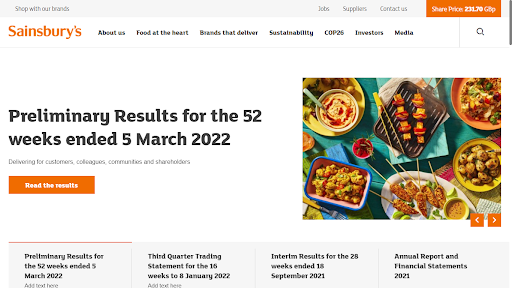
What we liked:
- The search bar is displayed prominently (sticky).
- The headlines for the latest Sainsbury’s news are easy-to-read in large font at the top of the page.
- Pictures are large and colorful, creating a much more engaging and user-friendly web-browsing experience.
- The store locator is easy to find.
- The “Inspiration” section is a great idea nicely implemented.
What we didn’t:
- The delivery options are not displayed at the top of the page, forcing the customer to scroll to the bottom to find them.
- Customers may have to click too many links to get started with their online shopping based on this format.
- There is less emphasis on grocery shopping at the top of the site when most customers would visit it for this purpose.
B. Analyzing Sainsbury’s Category Page
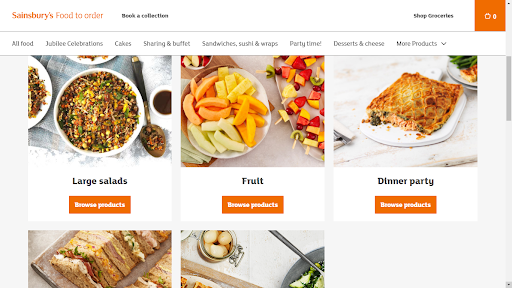
What we liked:
- The products are organized according to different types of events (e.g. “large salads” and “dinner party”).
- The layout allows customers to browse products easily.
- Products are grouped according to useful and intuitive categories, which both help customers find what they want and advertise for categories of related products.
What we didn’t:
- The page does not have enough product categories.
- The general “All Food” link at the top bar, apart from the fact that it is really generic as a definition, it’s also easy to miss.
- The types of products in each category are not quite clear.
- Filters/Facets button could be sticky on mobile.
C. Analyzing Sainsbury’s Product Page

What we liked:
- The products search bar is displayed clearly at the top of the page.
- The different categories of products are easily findable in a bar at the top of the page.
- A drop-down menu of ranges and values helps customers navigate different shopping options.
- The Nutrition section on grocery products is really useful and delivers value and good UX.
What we didn’t:
- Too much empty space in the middle of the page leaves the customer without much guidance on where to go.
- Login information, as well as the options for new users, are not visible enough at the top of the page.
- Search options are too open-ended for customers who are uncertain about what they need.
- The Add-to-Cart button could be sticky on mobile
D. Analyzing Sainsbury’s Checkout Process

What we liked:
- The products are matched with clear images for user-friendly, visual data.
- Customers can book slots for delivery times.
- The mobile site is easy to navigate.
- Checkout supports BOPIS (Buy Online Pickup In-Store)
What we didn’t:
- Larger orders can be tedious to view with limited page display sizes.
- Shopping categories and sales offers are not displayed distinctly.
- It could be easier for customers to choose and interact with the products they have highlighted as their “favorites.”
- Different shipping costs occur in Step #2. A smart tactic, but not a great implementation though.
- A little confusing checkout process by overpromoting to continue shopping.
Technologies Sainsbury’s could use to further increase its customer engagement
With its aforementioned focus on omnichannel marketing, Sainsbury’s would be able to benefit from the use of Samaritan, the latest product offered by ContactPigeon. Samaritan is an innovative omnichannel chat that allows companies to easily mediate the different avenues of their customer experiences.
In Sainsbury’s case, Samaritan offers useful services such as chatbots for personalized customer offers, exceptional and technologically-advanced customer support, and an extensive menu of common eCommerce questions that address most customer service needs. This function could easily help customers see offers and products that they may not have otherwise and have a more personalized shopping experience than they would get at any of its competitors.
Interesting technologies Sainsbury’s marketing strategy currently implements
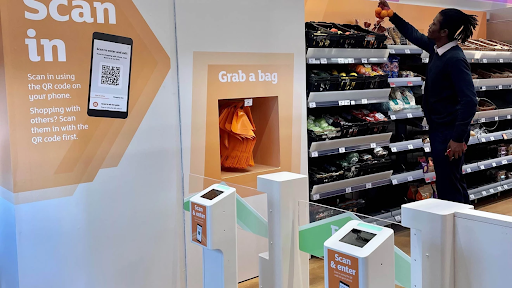
Using the buildwith tool, we scanned the giant’s UK website and highlighted the most impressive technologies spotted.
Just Walk Out
In 2020, Sainsbury’s announced that it would partner with Amazon to implement Amazon’s cutting edge “Just Walk Out” technology at a few select locations. This new tool allows Sainsbury’s to enact a much more streamlined shopping experience for its customers without the need for arduous and irritating checkout lines.
In this system, customers will use Sainsbury’s shopping app to scan a preexisting QR code at the store’s entry gate. Then, they can pick up whichever items they want and leave the store without needing to checkout. Upon leaving, customers will once more scan the QR code on their app, which will charge their account for any items they purchased. This investment in new technology will allow Sainsbury’s to further implement its omnichannel marketing strategy by creating an even more integrated and convenient shopping experience for its customers.
Pay@Browse
In 2016, Sainsbury’s introduced new Pay@Browse technology at several hundred of its select Argos locations. Using this technology, Sainsbury’s has given its Argos customers the convenient option of paying for their groceries digitally without having to wait in line at the store. This use of innovative, contactless technology proved to be so successful that the company soon announced that it would expand Pay@Browse compatibility to more than 200 more Argos locations by 2019.
Nectar Mobile App
In 2018, Sainsbury’s acquired the mobile app Nectar, which provided the company with further opportunities to improve its customers’ shopping experience through the innovative use of technological tools. By using Nectar, Sainsbury’s shoppers can earn rewards, get easy access to sales and promotions, and purchase items digitally. Sainsbury’s is now trailing a cutting-edge Nectar proposition for shoppers in Wales, with which they will be able to earn and spend their Nectar points using a convenient mobile app.
Sainsbury’s latest company news
- Sainsbury’s Drops Nectar Double Up Loyalty Promotion In Favour Of ‘Invite-only’ Offer (Source: Grocery Gazette)
- Sainsbury’s Revamps Same-day Delivery and Click-and-collect Services (Source: Retail Week)
- Sainsbury’s Partners With Carluccio’s for 3 In-store Concepts (Source: Retail Gazette)
- Sainsbury’s Partners With Itsu, Leon & Wasabi to Launch Its New Lunch Stand Concept (Source: Markets Insider)
Interesting Sainsbury’s statistics you should know
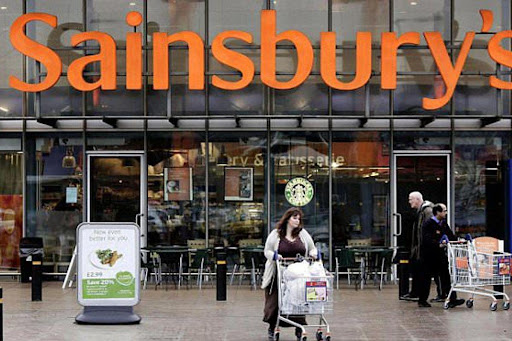
- In the 2020-2021 fiscal year, recording retail sales figures amounting to £28.6 billion.
- Retail sales increased from £18.9 billion to £28.6 billion from 2008 through 2021.
- In early 2022, Sainsbury’s grocery sales increased 0.8%.
- Sainsbury’s currently represents around 16% of total grocery retail sales in the United Kingdom.
- In 2019, Sainbury’s had 1,428 stores across the UK. Of these, 820 were convenience stores.
- As of 2022, Sainsbury’s offers around 90,000 different products at its stores and serves around 320,000 customers.
Discover more resources about FMCG retailers
- The Ocado marketing strategy: How it reached the UK TOP50 retailers list
- ASDA’s marketing strategy: How the British supermarket chain reached the top
- The Marks and Spencer eCommerce Case Study: 3 Growth Lessons for Retailers
- Tesco Case Study: How an Online Grocery Goliath Was Born
- ALDI’s marketing strategy: The key growth ingredients of the FMCG titan
- Walmart Marketing Strategy: Decoding the Success of the US Multinational Retailer
- Analyzing Lidl’s Marketing Strategy: How the Discount Supermarket Leader Scaled
- FMCG Marketing Strategies to Increase YOY Revenue
Grow(th) like Sainsbury’s
Within the often turbulent world of retail sales, Sainsbury’s case study provides an excellent example of how a retail business can implement new and innovative marketing objectives while maintaining the commitment to excellence that first allowed it to rise to prominence. All in all, Sainsbury’s success story is not the result of luck, but rather it is the result of a consistent growth strategy that emphasizes innovation, integration, and adaptation within both the physical and digital shopping realms. By successfully pursuing an omnichannel marketing approach, Sainsbury’s has risen from humble 19th Century origins to become the second-largest supermarket chain in the UK. It is one of the best examples of the benefits of successful marketing strategies for supermarkets as a whole.
While the recent COVID-19 pandemic has threatened and upended the traditional world of retailing, companies cannot remain idle if they wish to maintain, or even build, their customer base in potentially tough economic circumstances. The recent success of companies like Sainsbury’s shows that innovation and adaption in terms of marketing strategy can help a major company weather any storm. All of this is, of course, largely dependent upon the tools and platforms that a company has at its disposal.
Omnichannel marketing and related strategies require excellent resources to integrate and promote numerous marketing channels in a convenient and user-friendly medium. Before investing in a powerful omnichannel customer engagement platform, be sure to do sufficient research on its efficacy and success stories. If Sainsbury’s success story has inspired you to evolve your own brand, be sure to book a consultation call with ContactPigeon today.

Let’s Help You Scale Up
Spending time on Linkedin? Follow us and get notified of our thought-leadership content:



